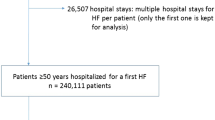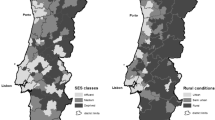Abstract
Summary
Using Portuguese hospital registers (2000–2002) we calculated age-standardized incidence rates of hip fractures. Spatial clusters of high incidence rates were found, with annual averages (per 100,000 inhabitants) varying from 154.4 to 572.2 and 77.3 to 231.5 for women and men, respectively. Geographic inequalities in the occurrence of hip fractures were also found.
Introduction
The aim of this study was to identify spatial patterns in the incidence of hip fracture in Portugal during the period 2000 to 2002.
Methods
From the National Hospital Discharge Register, admissions of patients (50 years of age or more) with low-energy hip fracture were selected. Age-standardized incidence rates in relation to the municipality of the patients’ place of residence were calculated. Empirical Bayes estimators were used to smooth the local risk and spatial statistics methods were used to identify spatial clusters.
Results
Of 25,634 hip fractures in individuals aged 50 years or more caused by low or moderate impact, 19,759 occurred in women (age, mean±SD, 80.6±8.6 years) and 5,875 in men (age 77.7±10.0 years). Incidence rates increased exponentially with age, being higher in women nation-wide (female to male ratio from 1.5 to 5.1). Significant geographic differences were found: the incidence rates (95% CI) varied from 154.4 (153.6–155.3) to 572.2 (569.5–575.0) in women and 77.3 (76.64–78.05) to 231.5 (229.9–233.0) in men per 100,000 inhabitants. Spatial autocorrelation values (Moran index) were 0.56 and 0.45 for women and men, respectively.
Conclusion
Spatial clusters (p<0.0001) of high incidences were identified. Geographic differences in incidence rates were about threefold. Some regions had incidence rates as high as some north European countries. The geographic inequalities could be due to environmental or socioeconomic factors, but further investigation needs to be done to confirm this hypothesis.





Similar content being viewed by others
References
Center J, Eisman J (1997) The epidemiology and pathogenesis of osteoporosis. Baillieres Clin Endocrinol Metab 11(1):23–62
Cooper C, Melton LJ III (1996) Magnitude and Impact of osteoporosis and fractures. In: Marcus R, Feldman D, Kelsey J (eds) Osteoporosis. Academic Press, San Diego, pp 419–434
Walker-Bone K, Dennison E, Cooper C (2001) Epidemiology of osteoporosis. Rheum Dis Clin North Am 27(1):1–18
Cummings SR, Melton LJ III (2002) Epidemiology and outcomes of osteoporotic fractures. Lancet 359:1761–1767
Cooper C, Campion G, Melton LJ (1992) Hip fractures in the elderly: a world-wide projection. Osteoporos Int 2:285–289
Karagas MR, Lu-Yao GL Barrett JA et al (1996) Heterogeneity of hip fracture: age, race, sex, and geographic patterns of femoral neck and trochanteric fractures among the US elderly. Am J Epidemiol 143(7):677–682
Jordan KM, Cooper C (2002) Epidemiology of osteoporosis. Best Pract Res Clin Rheumatol 16(5):795–806
Orimo H, Hashimoto T, Sakata K et al (2000) Trends in the incidence of hip fracture in Japan, 1987–1997: the third nationwide survey. J Bone Miner Metab 18:126–131
Kennedy S (1994) The small number problem and the accuracy of spatial databases. In: Goodchild M, Gopal S (eds) Accuracy of spatial databases. Taylor and Francis, London, pp 187–196
Bailey TC, Gatrell AC (eds) (1995) Interactive spatial data analysis. Longman, London
Anselin L (1995) Local indicators of spatial association – LISA. Geogr Anal 27(2):93–115
Chevalley T, Herrmann FR, Delmi M et al (2002) Evaluation of the age-adjusted incidence of hip fractures between urban and rural areas: the difference is not related to the prevalence of institutions for the elderly. Osteoporos Int 13:113–118
Sanders K, Nicholson GC, Ugoni AM et al (2002) Fracture rates lower in rural than urban communities: the Geelong Osteoporosis Study. J Epidemiol Community Health 56:466–470
Vaz AL (1993) Epidemiology and costs of osteoporotic hip fractures in Portugal. Bone 14 [Suppl 1]:S9
Lofthus CM, Osnes EK, Falch JA et al (2001) Epidemiology of hip fractures in Oslo, Norway. Bone 29(5):413–418
Nydegger V, Rizzoli R, Rapin CH et al (1991) Epidemiology of fractures of the proximal femur in Geneva: incidence, clinical and social aspects. Osteoporos Int 2(1):42–47
Hernandez J, Olmos JM, Alonso MA et al (2006) Trend in hip fracture epidemiology over a 14-year period in a Spanish population. Osteoporos Int 17:464–470
Giversen IM (2006) Time trends of age-adjusted incidence rates of first hip fractures: a register-based study among older people in Viborg County, Denmark, 1987–1997. Osteoporos Int 17:552–564
Coster A, Haberkamp M, Allolio B (1994) Incidence of femoral neck fractures in the German Federal Republic in comparison to other countries. Soz Praventivmed 39(5):287–292
Paspati I, Galanos A, Lyritis GP (1998) Hip fracture epidemiology in Greece during 1977–1992. Calcif Tissue Int 62(6):542–547
Kannus P, Niemi S, Parkkari J et al (1999) Hip fractures in Finland between 1970 and 1997 and predictions for the future. Lancet 353(9155):802–805
Acknowledgements
The authors acknowledge the support of the Portuguese Foundation for Science (grant no. POCI/SAU-ESP/58605/2004).
Conflicts of interest
None.
Author information
Authors and Affiliations
Corresponding author
Rights and permissions
About this article
Cite this article
de Pina, M.F., Alves, S.M., Barbosa, M. et al. Hip fractures cluster in space: an epidemiological analysis in Portugal. Osteoporos Int 19, 1797–1804 (2008). https://doi.org/10.1007/s00198-008-0623-1
Received:
Accepted:
Published:
Issue Date:
DOI: https://doi.org/10.1007/s00198-008-0623-1




